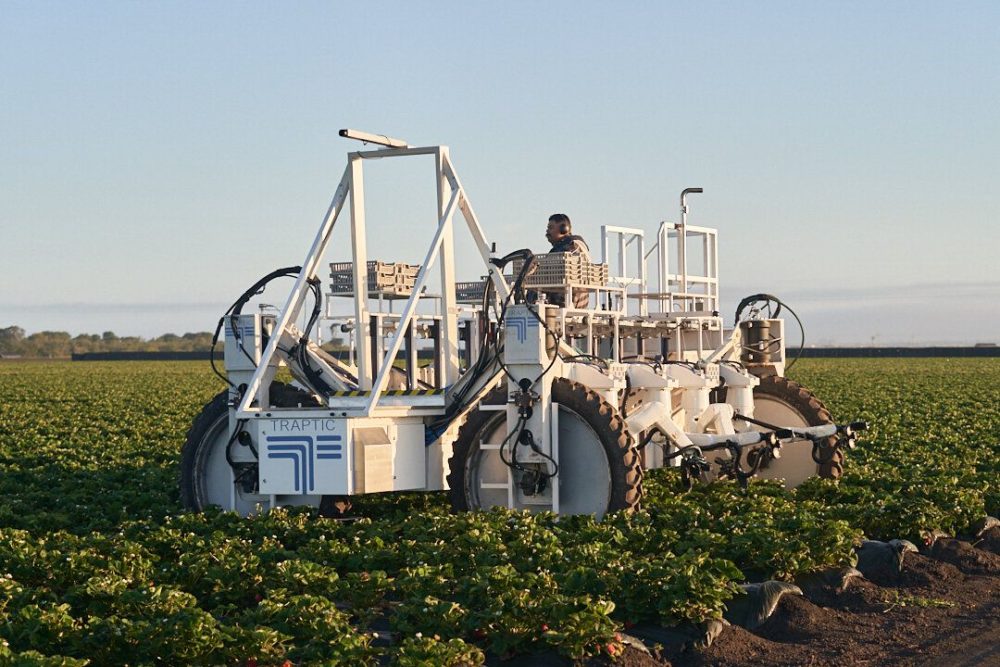Disclosure: AFN’s parent company, AgFunder, is an investor in Root AI and Tevel.
Last week, New York vertical farming company Bowery announced that it had acquired Mountain View, California-based ag robotics startup Traptic for an undisclosed sum.
- Founded in 2016, Traptic has developed “giant farming robots” that use a combination of AI, computer vision, and robotics technologies to harvest delicate crops.
- The robots were originally built for use in open-field settings; Bowery will be “the first indoor farming company to use Traptic technology,” it said in a press release.
- It added that Traptic’s tech will “accelerate the commercialization of [Bowery’s] fruiting and vine crops,” including strawberries in particular.
- Traptic’s team will join Bowery, and its co-founder and CEO Lewis Anderson will become the vertical farming firm’s senior director of robotics solutions – reporting to vice president of robotics and automation, Justin Frankert.
- Collaborative Fund, Homebrew Ventures, and K9 Ventures are among the investors to have previously backed Traptic.
Here, AFN breaks down what the deal means for Bowery – and the broader indoor ag space.
On background:
Bowery claims to be the largest vertical farming company in the US. Its leafy greens are stocked by “major e-commerce platforms and more than 800 grocery stores” — mainly on the East Coast — including Acme, Amazon Fresh, Giant Food, Safeway, Wakefern, Walmart, Weis, and Whole Foods.

It was reportedly valued at $2.3 billion following its $300 million Series C raise in May 2021, which was said to be the largest-ever funding round for an indoor farming company at the time (San Francisco-based competitor Plenty appears to have smashed that record when it raised $400 million for its Series E round last month.)
Following a further $150 million fundraise in the form of a credit facility last month, Bowery is aiming to expand its product range beyond leafy greens to include strawberries, tomatoes, and other “delicate” crops. The acquisition of Traptic is specifically aligned with this strategy.
Why it matters:
Controlled environment agriculture (CEA) makes use of various technologies to create optimal growing conditions and maximize yields.
- Robots may be preferred to human laborers as they can operate in the much tighter spaces associated with vertical farms, at all times of day, are generally more consistent, and come with a lower contamination risk (many CEA setups try to minimize the presence of foreign microbes and other contaminants in an effort to preserve plant health and reduce reliance on chemical inputs.)
- They also overcome the challenge of sourcing qualified labor, which is in short supply across the agriculture sector.
CEA operations may develop some of their tech in-house (for its part, Bowery has built its own automation and farm management platform, BoweryOS, which it describes as “the central nervous system of the business.”) For other solutions, they can turn to M&A in order to bring in the tech they need – as is the case with Traptic.
Another notable example of the latter is greenhouse operator AppHarvest‘s April 2021 acquisition of Root AI, a builder of harvesting robots.
However, Root AI’s robots were originally designed to work indoors; Traptic’s have been built for open field harvesting.
But the attraction of Traptic would seem to be more about specific parts of its technology, rather than the finished article that has been demoed.

Speaking to AFN, Bowery chief technology officer Injong Rhee highlighted the dexterity and precision of Traptic’s robots, which are enabled by their heightened capabilities in “3D localization and pathing.”
“Their robot arms are kind of off-the-shelf commodity arms. But they customized them, adding 3D cameras and gripper tech which allows them to pick strawberries without damaging fruits and leaves,” he explained.
“This has a lot of applications; it’s not just for picking berries,” he added. “For a lot of fruiting crops, it also can be used to pollinate strawberries for instance [as it can] identify flowers easily.”
The bigger picture:
Several commentators have suggested that CEA has entered a ‘trough of disillusionment,’ with many of the sector’s most well-capitalized players yet to make a significant dent on food supplies despite a decade or more of substantial funding from VCs and, more recently, public market investors.
Since it went public by SPAC merger one year ago, AppHarvest’s performance has been underwhelming; while US vertical farm operator AeroFarms and SPAC Spring Valley cancelled their $1.2 billion merger in October, deeming it “not in the best interests of our shareholders.”
The point has been made that indoor ag companies are trying to succeed at several very different things at once — crop yield optimization, product distribution, and tech development — each requiring different expertise and strategies.
M&A can offer a more expeditious route to building capabilities in some of these areas, while allowing the business to focus existing internal resources on the others.
By the numbers:
In 2020 — the most recent year for which AgFunder has complete data — venture funding into farm robotics startups saw a significant boost.
- In total, $212 million was invested in the Farm Robotics, Mechanization & Equipment category, representing 15% growth over 2019. The category’s median deal size also grew by 22% – indicative that bigger checks were being cut as several startups matured into later-stage companies.
- Some of the biggest VC deals in the category in 2020 included Israeli fruit-picking drone startup Tevel‘s $20 million raise; and the $16 million Series A round for France’s Naïo Technologies, which builds weeding robots.
- Bowery itself secured H1 2021’s biggest VC deal in the Novel Farming Systems category, which includes CEA. As mentioned above, it raised $300 million from investors including Fidelity, Gaingels, General Catalyst, GGV Capital, Temasek, and Google affiliate GV in May.




